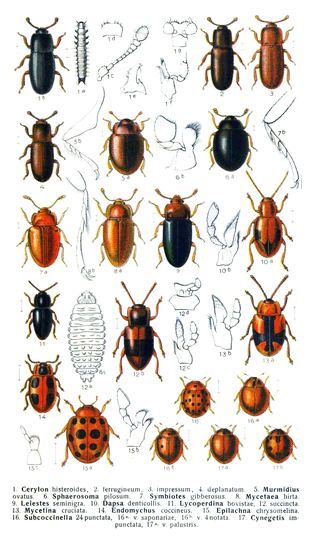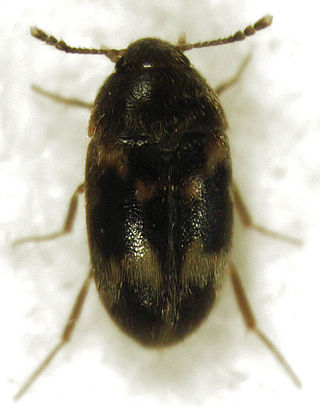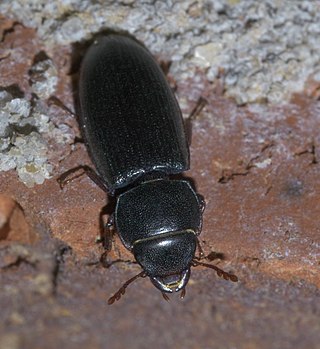
The Phalacridae are a family of beetles commonly called the shining flower beetles, They are often found in composite flowers. They are oval-shaped, usually tan, and about 2 mm in length. Most species feed on fungus, although a number feed on flower heads.

Scydmaeninae are a subfamily of small beetles, commonly called ant-like stone beetles or scydmaenines. These beetles occur worldwide, and the subfamily includes some 4,500 species in about 80 genera. Established as a family, they were reduced in status to a subfamily of Staphylinidae in 2009

William Kirby was an English entomologist, an original member of the Linnean Society and a Fellow of the Royal Society, as well as a country rector, so that he was an eminent example of the "parson-naturalist". The four-volume Introduction to Entomology, co-written with William Spence, was widely influential.

Cucujoidea is a superfamily of beetles. This group formerly included all of the families now included in the superfamily Coccinelloidea. They include some fungus beetles and a diversity of lineages of "bark beetles" unrelated to the "true" bark beetles (Scolytinae), which are weevils.

William Spence was a British economist and entomologist.

Noctuoidea is the superfamily of noctuid or "owlet" moths, and has more than 70,000 described species, the largest number of any Lepidopteran superfamily. Its classification has not yet reached a satisfactory or stable state. Since the end of the 20th century, increasing availability of molecular phylogenetic data for this hugely successful radiation has led to several competing proposals for a taxonomic arrangement that correctly represents the relationships between the major lineages.

Staphylinoidea is a superfamily of beetles. It is a very large and diverse group with worldwide distribution.

Flower chafers are a group of scarab beetles comprising the subfamily Cetoniinae. Many species are diurnal and visit flowers for pollen and nectar, or to browse on the petals. Some species also feed on fruit. The group is also called fruit and flower chafers, flower beetles and flower scarabs. There are around 4,000 species, many of them still undescribed.

The Mycetophagidae or hairy fungus beetles are a family of beetles in the superfamily Tenebrionoidea. The different species are between 1.0 and 6.5 mm in length. The larvae and adults live in decaying leaf litter, fungi, and under bark. Most species feed on fungi. Worldwide, the 18 genera contain around 200 species.

Salpingidae or narrow-waisted bark beetles is a family of beetles in the superfamily Tenebrionoidea. The species are small, about 1.5 – 7 mm in length. The family is globally distributed and consists of about 45 genera and 300 species, which are generally found in the temperate regions of both hemispheres. The family is mainly associated with plants as well as with ascomycete and hyphomycete fungi. Some members of the family are associated with unusual habitats, like Aegialites and Antarcticodomus, which are found in coastal areas including the intertidal zone, with former feeding on algae.

Hemicrepidius is a genus of click beetle belonging to the family Elateridae.

Silphinae is a subfamily of burying beetles or carrion beetles. There are 113 extant species of this subfamily, in two tribe and in 14 genera. It contains the following tribes and genera:

Melolonthini is a tribe of scarab beetles in the family Scarabaeidae. There are over 250 genera in Melolonthini, occurring worldwide; there are over 300 species in North America alone, and more than 3000 worldwide.

Xenoscelinae is a subfamily of pleasing fungus beetles in the family Erotylidae. There are about 8 genera and 12 described species in Xenoscelinae.

Tenebroides is a genus of bark-gnawing beetles in the family Trogossitidae. There are at least 20 described species in Tenebroides.

Cetoniini is a tribe of fruit and flower chafers in the family of beetles known as Scarabaeidae. There are over 80 genera in Cetoniini, found worldwide.

Rhadalidae are a family of beetles of the superfamily Cleroidea, formerly treated as a subfamily within the family Melyridae. The adults are predators or feed on pollen, while the larvae are probably carnivorous.
















